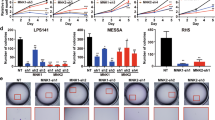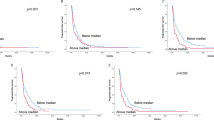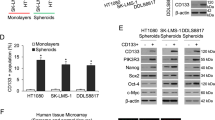Abstract
Tight junction protein 1 (TJP1) is a membrane-associated cytosolic protein important for cell–cell communication in intercellular barriers in epithelial and non-epithelial cells. Here, we explored the functional involvement of TJP1 in non-epithelial tumors such as soft tissue sarcoma, especially in leiomyosarcoma (LMS). TJP1 expression in soft tissue sarcoma was analyzed in normal and tumor tissues as well as from public datasets such as the TCGA provisional dataset, in which TJP1 expression was compared with other subtypes such as undifferentiated sarcomas, and myxofibrosarcomas. SK-LMS-1 cell lines with reduced TJP1 expression showed attenuated anchorage-independent colony formation as well as reduced intercellular aggregation on non-coated culture plates compared with control as well as parental SK-LMS-1 cells. Transcriptome profiling following TJP1 knockdown in SK-LMS-1 cells suggested the involvement of several signaling pathways, including NF-κB pathway and growth factor receptor signaling. In addition, TJP1 downregulation induced enhanced response against anti-cancer agents, doxorubicin and gefitinib. Taken together, these results suggest that TJP1 contributes to sarcoma genesis and might be useful therapeutic target.
Key messages
• TJP1 expression at RNA level higher in tumor than in normal tissues of sarcoma.
• Targeting TJP1 attenuates cell–cell aggregation and anchorage-independent growth.
• Targeting TJP1 is beneficial in anti-cancer therapy in LMS.






Similar content being viewed by others
References
Matushansky I, Maki RG (2005) Mechanisms of sarcomagenesis. Hematol Oncol Clin North Am 19:427–449
Barretina J, Taylor BS, Banerji S, Ramos AH, Lagos-Quintana M, Decarolis PL, Shah K, Socci ND, Weir BA, Ho A et al (2010) Subtype-specific genomic alterations define new targets for soft-tissue sarcoma therapy. Nat Genet 42:715–721
Cancer Genome Atlas Research Network. Electronic address edsc, Cancer Genome Atlas Research N (2017) Comprehensive and integrated genomic characterization of adult soft tissue sarcomas. Cell 171: 950–965 e928. DOI https://doi.org/10.1016/j.cell.2017.10.014, 950, 965.e28
Kim J, Kim JH, Kang HG, Park SY, Yu JY, Lee EY, Oh SE, Kim YH, Yun T, Park C, Cho SY, You HJ (2018) Integrated molecular characterization of adult soft tissue sarcoma for therapeutic targets. BMC Med Genet 19:216
Chibon F, Lagarde P, Salas S, Perot G, Brouste V, Tirode F, Lucchesi C, de Reynies A, Kauffmann A, Bui B et al (2010) Validated prediction of clinical outcome in sarcomas and multiple types of cancer on the basis of a gene expression signature related to genome complexity. Nat Med 16:781–787
Howlader N., Noone A. M., Krapcho M., Miller D., Bishop K., Kosary C. L., Yu M., Ruhl J., Tatalovich Z., Mariotto A., et al. (2017) SEER Cancer Statistics Review, 1975-2014National Cancer Institute, Bethesda
Fanning AS, Jameson BJ, Jesaitis LA, Anderson JM (1998) The tight junction protein ZO-1 establishes a link between the transmembrane protein occludin and the actin cytoskeleton. J Biol Chem 273:29745–29753
Coindre JM, Terrier P, Guillou L, Le Doussal V, Collin F, Ranchere D, Sastre X, Vilain MO, Bonichon F, N'Guyen Bui B (2001) Predictive value of grade for metastasis development in the main histologic types of adult soft tissue sarcomas: a study of 1240 patients from the French Federation of Cancer Centers Sarcoma Group. Cancer 91:1914–1926
Chudasama P, Mughal SS, Sanders MA, Hubschmann D, Chung I, Deeg KI, Wong SH, Rabe S, Hlevnjak M, Zapatka M et al (2018) Integrative genomic and transcriptomic analysis of leiomyosarcoma. Nat Commun 9:144
Sharma S, Takyar S, Manson SC, Powell S, Penel N (2013) Efficacy and safety of pharmacological interventions in second- or later-line treatment of patients with advanced soft tissue sarcoma: a systematic review. BMC Cancer 13:385
Taylor BS, Barretina J, Maki RG, Antonescu CR, Singer S, Ladanyi M (2011) Advances in sarcoma genomics and new therapeutic targets. Nat Rev Cancer 11:541–557
Judson I, Verweij J, Gelderblom H, Hartmann JT, Schoffski P, Blay JY, Kerst JM, Sufliarsky J, Whelan J, Hohenberger P et al (2014) Doxorubicin alone versus intensified doxorubicin plus ifosfamide for first-line treatment of advanced or metastatic soft-tissue sarcoma: a randomised controlled phase 3 trial. Lancet Oncol 15:415–423
Mouridsen HT, Bastholt L, Somers R, Santoro A, Bramwell V, Mulder JH, van Oosterom AT, Buesa J, Pinedo HM, Thomas D, Sylvester R (1987) Adriamycin versus epirubicin in advanced soft tissue sarcomas. A randomized phase II/phase III study of the EORTC Soft Tissue and Bone Sarcoma Group. Eur J Cancer Clin Oncol 23:1477–1483
In GK, Hu JS, Tseng WW (2017) Treatment of advanced, metastatic soft tissue sarcoma: latest evidence and clinical considerations. Ther Adv Med Oncol 9:533–550
Barone A, Chi DC, Theoret MR, Chen H, He K, Kufrin D, Helms WS, Subramaniam S, Zhao H, Patel A, Goldberg KB, Keegan P, Pazdur R (2017) FDA approval summary: trabectedin for unresectable or metastatic Liposarcoma or leiomyosarcoma following an anthracycline-containing regimen. Clin Cancer Res 23:7448–7453
Demetri GD, von Mehren M, Jones RL, Hensley ML, Schuetze SM, Staddon A, Milhem M, Elias A, Ganjoo K, Tawbi H, van Tine BA, Spira A, Dean A, Khokhar NZ, Park YC, Knoblauch RE, Parekh TV, Maki RG, Patel SR (2016) Efficacy and safety of trabectedin or dacarbazine for metastatic liposarcoma or leiomyosarcoma after failure of conventional chemotherapy: results of a phase III randomized multicenter clinical trial. J Clin Oncol 34:786–793
Patel S, von Mehren M, Reed DR, Kaiser P, Charlson J, Ryan CW, Rushing D, Livingston M, Singh A, Seth R, Forscher C, D'Amato G, Chawla SP, McCarthy S, Wang G, Parekh T, Knoblauch R, Hensley ML, Maki RG, Demetri GD (2019) Overall survival and histology-specific subgroup analyses from a phase 3, randomized controlled study of trabectedin or dacarbazine in patients with advanced liposarcoma or leiomyosarcoma. Cancer 125:2610–2620
Blay JY, Schoffski P, Bauer S, Krarup-Hansen A, Benson C, D'Adamo DR, Jia Y, Maki RG (2019) Eribulin versus dacarbazine in patients with leiomyosarcoma: subgroup analysis from a phase 3, open-label, randomised study. Br J Cancer 120:1026–1032
van der Graaf WT, Blay JY, Chawla SP, Kim DW, Bui-Nguyen B, Casali PG, Schoffski P, Aglietta M, Staddon AP, Beppu Y et al (2012) Pazopanib for metastatic soft-tissue sarcoma (PALETTE): a randomised, double-blind, placebo-controlled phase 3 trial. Lancet 379:1879–1886
Chen HW, Chen TW (2020) Genomic-guided precision therapy for soft tissue sarcoma. ESMO Open 5:5
Le DT, Durham JN, Smith KN, Wang H, Bartlett BR, Aulakh LK, Lu S, Kemberling H, Wilt C, Luber BS et al (2017) Mismatch repair deficiency predicts response of solid tumors to PD-1 blockade. Science 357:409–413
George S, Miao D, Demetri GD, Adeegbe D, Rodig SJ, Shukla S, Lipschitz M, Amin-Mansour A, Raut CP, Carter SL, Hammerman P, Freeman GJ, Wu CJ, Ott PA, Wong KK, van Allen EM (2017) Loss of PTEN is associated with resistance to anti-PD-1 checkpoint blockade therapy in metastatic uterine leiomyosarcoma. Immunity 46:197–204
Salvador E, Burek M, Forster CY (2016) Tight junctions and the tumor microenvironment. Curr Pathobiol Rep 4:135–145
Bauer H, Zweimueller-Mayer J, Steinbacher P, Lametschwandtner A, Bauer HC (2010) The dual role of zonula occludens (ZO) proteins. J Biomed Biotechnol 2010:402593
Howarth AG, Hughes MR, Stevenson BR (1992) Detection of the tight junction-associated protein ZO-1 in astrocytes and other nonepithelial cell types. Am J Phys 262:C461–C469
Van Itallie CM, Aponte A, Tietgens AJ, Gucek M, Fredriksson K, Anderson JM (2013) The N and C termini of ZO-1 are surrounded by distinct proteins and functional protein networks. J Biol Chem 288:13775–13788
Lesage J, Suarez-Carmona M, Neyrinck-Leglantier D, Grelet S, Blacher S, Hunziker W, Birembaut P, Noel A, Nawrocki-Raby B, Gilles C et al (2017) Zonula occludens-1/NF-kappaB/CXCL8: a new regulatory axis for tumor angiogenesis. FASEB J 31:1678–1688
Zhang XD, Baladandayuthapani V, Lin H, Mulligan G, Li B, Esseltine DW, Qi L, Xu J, Hunziker W, Barlogie B et al (2016) Tight junction protein 1 modulates proteasome capacity and proteasome inhibitor sensitivity in multiple myeloma via EGFR/JAK1/STAT3 signaling. Cancer Cell 29:639–652
Riz I, Hawley RG (2017) Increased expression of the tight junction protein TJP1/ZO-1 is associated with upregulation of TAZ-TEAD activity and an adult tissue stem cell signature in carfilzomib-resistant multiple myeloma cells and high-risk multiple myeloma patients. Oncoscience 4:79–94
Dodd RD, Mito JK, Kirsch DG (2010) Animal models of soft-tissue sarcoma. Dis Model Mech 3:557–566
Hayashi T, Faustman DL (2002) Development of spontaneous uterine tumors in low molecular mass polypeptide-2 knockout mice. Cancer Res 62:24–27
Ran FA, Hsu PD, Wright J, Agarwala V, Scott DA, Zhang F (2013) Genome engineering using the CRISPR-Cas9 system. Nat Protoc 8:2281–2308
Cerami E, Gao J, Dogrusoz U, Gross BE, Sumer SO, Aksoy BA, Jacobsen A, Byrne CJ, Heuer ML, Larsson E, Antipin Y, Reva B, Goldberg AP, Sander C, Schultz N (2012) The cBio cancer genomics portal: an open platform for exploring multidimensional cancer genomics data. Cancer Discov 2:401–404
Tang Z, Li C, Kang B, Gao G, Li C, Zhang Z (2017) GEPIA: a web server for cancer and normal gene expression profiling and interactive analyses. Nucleic Acids Res 45:W98–W102
Paek AR, Lee CH, You HJ (2014) A role of zinc-finger protein 143 for cancer cell migration and invasion through ZEB1 and E-cadherin in colon cancer cells. Mol Carcinog 53(Suppl 1):E161–E168
Verma V, Paek AR, Choi BK, Hong EK, You HJ (2019) Loss of zinc-finger protein 143 contributes to tumour progression by interleukin-8-CXCR axis in colon cancer. J Cell Mol Med 23:4043–4053
Livak KJ, Schmittgen TD (2001) Analysis of relative gene expression data using real-time quantitative PCR and the 2(−Delta Delta C(T)) method. Methods 25:402–408
Paek AR, Mun JY, Hong KM, Lee J, Hong DW, You HJ (2017) Zinc finger protein 143 expression is closely related to tumor malignancy via regulating cell motility in breast cancer. BMB Rep 50:621–627
Van Itallie CM, Tietgens AJ, Krystofiak E, Kachar B, Anderson JM (2015) A complex of ZO-1 and the BAR-domain protein TOCA-1 regulates actin assembly at the tight junction. Mol Biol Cell 26:2769–2787
Li B, Dewey CN (2011) RSEM: accurate transcript quantification from RNA-Seq data with or without a reference genome. BMC Bioinformatics 12:323
Brandner JM, Kief S, Grund C, Rendl M, Houdek P, Kuhn C, Tschachler E, Franke WW, Moll I (2002) Organization and formation of the tight junction system in human epidermis and cultured keratinocytes. Eur J Cell Biol 81:253–263
Raudvere U, Kolberg L, Kuzmin I, Arak T, Adler P, Peterson H, Vilo J (2019) g:Profiler: a web server for functional enrichment analysis and conversions of gene lists (2019 update). Nucleic Acids Res 47:W191–W198
Dangoor A, Seddon B, Gerrand C, Grimer R, Whelan J, Judson I (2016) UK guidelines for the management of soft tissue sarcomas. Clin Sarcoma Res 6:20
Demetri GD, Le Cesne A, Chawla SP, Brodowicz T, Maki RG, Bach BA, Smethurst DP, Bray S, Hei YJ, Blay JY (2012) First-line treatment of metastatic or locally advanced unresectable soft tissue sarcomas with conatumumab in combination with doxorubicin or doxorubicin alone: a phase I/II open-label and double-blind study. Eur J Cancer 48:547–563
Wakeling AE, Guy SP, Woodburn JR, Ashton SE, Curry BJ, Barker AJ, Gibson KH (2002) ZD1839 (Iressa): an orally active inhibitor of epidermal growth factor signaling with potential for cancer therapy. Cancer Res 62:5749–5754
Hirsch FR, Sequist LV, Gore I, Mooradian M, Simon G, Croft EF, DeVincenzo D, Munley J, Stein D, Freivogel K, Sifakis F, Bunn PA Jr (2018) Long-term safety and survival with gefitinib in select patients with advanced non-small cell lung cancer: results from the US IRESSA Clinical Access Program (ICAP). Cancer 124:2407–2414
Ray-Coquard I, Le Cesne A, Whelan JS, Schoffski P, Bui BN, Verweij J, Marreaud S, van Glabbeke M, Hogendoorn P, Blay JY (2008) A phase II study of gefitinib for patients with advanced HER-1 expressing synovial sarcoma refractory to doxorubicin-containing regimens. Oncologist 13:467–473
Verma N, Rai AK, Kaushik V, Brunnert D, Chahar KR, Pandey J, Goyal P (2016) Identification of gefitinib off-targets using a structure-based systems biology approach; their validation with reverse docking and retrospective data mining. Sci Rep 6:33949
Lee SH, Paek AR, Yoon K, Kim SH, Lee SY, You HJ (2015) Tight junction protein 1 is regulated by transforming growth factor-beta and contributes to cell motility in NSCLC cells. BMB Rep 48:115–120
Saias L, Gomes A, Cazales M, Ducommun B, Lobjois V (2015) Cell-cell adhesion and cytoskeleton tension oppose each other in regulating tumor cell aggregation. Cancer Res 75:2426–2433
Acknowledgements
We thank Mi Ae Kim of the Microscopy Core (National Cancer Center), Tae Sik Kim of the FACS core (National Cancer Center), and Mi Sun Park of Animal Laboratory (National Cancer Center) for their expert assistance and helpful suggestions. Also, we thank the NCC sarcoma research group (National Cancer Center) for their advice as well as assistance in managing information, and sampling process.
Funding
This work was supported in part by National Cancer Center Grant NCC-1710252, NCC-1810865 (to HJYOU) and National Research Foundation of Korea Grant funded by the Korea Government (MSIP, South Korea) (No. 2019R1H1A2039666, to HJYOU).
Author information
Authors and Affiliations
Corresponding author
Ethics declarations
Conflict of interest
The authors declare that they have no conflict of interest.
Ethics statement
The study was vetted by the Ethics Review Board of the National Cancer Center, Korea (IRB No.: NCC2017-0062). The study was performed according to the principles of the Declaration of Helsinki.
Additional information
Publisher’s note
Springer Nature remains neutral with regard to jurisdictional claims in published maps and institutional affiliations.
Rights and permissions
About this article
Cite this article
Lee, EY., Yu, J.Y., Paek, A.R. et al. Targeting TJP1 attenuates cell–cell aggregation and modulates chemosensitivity against doxorubicin in leiomyosarcoma. J Mol Med 98, 761–773 (2020). https://doi.org/10.1007/s00109-020-01909-8
Received:
Revised:
Accepted:
Published:
Issue Date:
DOI: https://doi.org/10.1007/s00109-020-01909-8




